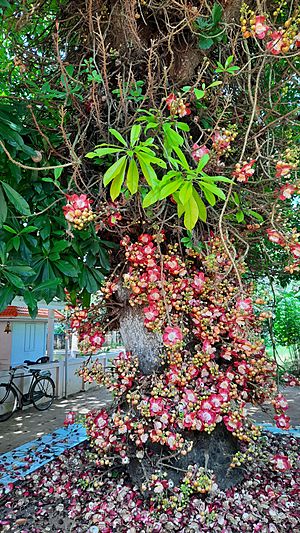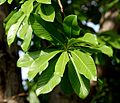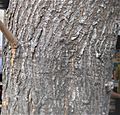Couroupita guianensis facts for kids
Quick facts for kids Couroupita guianensis |
|
|---|---|
 |
|
| Conservation status | |
| Scientific classification | |
| Genus: |
Couroupita
|
| Species: |
guianensis
|
| Synonyms | |
|
|
The cannonball tree (scientific name: Couroupita guianensis) is a special tree. It gets its name from its large, round fruits that look like cannonballs! This tree is a deciduous tree, which means it loses its leaves every year. It belongs to the flowering plant family called Lecythidaceae.
You can find the cannonball tree naturally in the tropical forests of Central and South America. People also grow it in many other warm places around the world. They love it for its beautiful, sweet-smelling flowers and its interesting, big fruits. The fruits are brownish-grey. Parts of the cannonball tree have been used in traditional medicine. This tree is also very important in the culture and religions of India. In Sri Lanka, people sometimes confused it with another tree called Sal. This happened after the British brought the cannonball tree to the island in 1881. Because of this, you can often see cannonball trees planted at Buddhist temples.
Contents
About the Cannonball Tree
The cannonball tree can grow very tall, reaching heights of up to 35 m (110 ft). That's as tall as a 10-story building! Its leaves grow in bunches at the ends of its branches. They are usually 8 to 31 centimeters (3 to 12 inches) long. Some leaves can even grow up to 57 cm (22 in) long.
Flowers
The flowers of the cannonball tree grow in long clusters called racemes. These clusters can be up to 80 cm (31 in) long. Sometimes, a tree will have so many flowers that its whole trunk is covered with them! One tree can have as many as 1,000 flowers blooming every day.
The flowers have a very strong, pleasant smell. They smell especially nice at night and in the early morning. Each flower is about 6 cm (2.4 in) wide and has six petals. The petals are usually bright colors, like pink and red near the bottom, turning yellowish towards the tips. Inside the flower, there are two groups of stamens (the parts that make pollen). One group forms a ring in the middle, and the other group is shaped like a hood.
Fruits
The fruits are round and have a hard, woody shell. They can grow up to 25 cm (9.8 in) across. This large, round shape is why the tree is called the "cannonball tree." Smaller fruits might have about 65 seeds inside. Very large ones can hold up to 550 seeds! One tree can produce about 150 fruits.
It takes a long time for the fruits to ripen, usually up to a year. Sometimes it can even take 18 months. The inside of the fruit is white. When it touches the air, it turns blue.
Scientific Name and Origin
The French botanist Jean Baptiste Christophore Fusée Aublet gave the tree its scientific name, Couroupita guianensis, in 1775.
The second part of its name, guianensis, is Latin. It means "of the Guianas." The Guianas are an area in northeastern South America.
How the Tree is Pollinated
Even though the cannonball tree flowers don't have nectar, they are very popular with bees. The bees come to collect the pollen. The flowers make two kinds of pollen:
- Fertile pollen comes from the stamens in the central ring.
- Sterile pollen comes from the hood-shaped structure.
When bees gather pollen, they have to move between these two areas of stamens. This helps the flowers get pollinated. A type of carpenter bee called Xylocopa brasilianorum often pollinates these trees in Rio de Janeiro. Other carpenter bees, wasps, flower flies, and bumblebees also visit the flowers.
How Seeds are Spread
Animals help spread the seeds of the cannonball tree by eating the fruits. When a fruit falls to the ground, its hard, woody shell usually cracks open. This lets animals get to the soft pulp and seeds inside. If a fruit stays whole, animals like peccaries might break it open.
Many animals enjoy eating the fruit's pulp and seeds. These include peccaries, the paca, and even farm animals like chickens and pigs. The seeds are covered with tiny hairs called trichomes. These hairs might help protect the seeds as they pass through the animals' digestive systems.
Human Uses of the Tree
People plant Couroupita guianensis as an ornamental tree. This means they grow it because its showy, fragrant flowers are beautiful to look at. It's also grown in botanical gardens because its fruits are so interesting.
The fruit can be eaten, but most people don't eat it. This is because, even though the flowers smell wonderful, the fruit itself can have an unpleasant smell. However, it is sometimes fed to farm animals like pigs and chickens.
Parts of the cannonball tree have been used in traditional medicine for a long time. People have used it for various purposes, such as to help with pain, swelling, and skin problems.
Cultural Importance
In India, the cannonball tree is considered sacred by Hindus. They believe that its hooded flowers look like the nāga (a mythical serpent) protecting a Lingam (a symbol of the god Shiva). Because of this belief, the tree is often planted at Shiva temples.
The cannonball tree has also been planted at Buddhist and Hindu religious sites in Asia. People believe it is the tree mentioned in sacred writings. In countries like Sri Lanka and Thailand, which follow Theravada Buddhism, you can find these trees at Buddhist monasteries and other religious places.
Gallery
-
A flower (Singapore Botanic Gardens)
See also
 In Spanish: Ayahuma para niños
In Spanish: Ayahuma para niños











